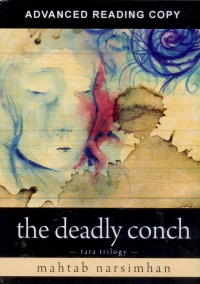| ________________
CM . . .
. Volume XVII Number 9. . . .October 29, 2010
excerpt:
When she returns in triumph to Morni, Tara justly feels she has overcome Zarku and Kali and their evil and deserves something of a hero’s welcome. But to her astonishment, the admiration and friendship of the villagers is short-lived. A dead dog is left in the temple, and the wells of both Morni and the neighbouring village are contaminated, and suddenly the villagers are suspicious that Tara is behind these events and is bringing bad luck to everyone. Tara realizes that, although her evil stepmother Kali is dead, she has the power to seek revenge through her daughter Layla. Try as she might, Tara cannot convince the villagers that Layla is behind all of these malicious acts. Since no one believes her, Tara summons up her last ounce of courage and call for the help of Lord Yama and his deadly conch. Lord Yama escorts Tara to the Underworld to seek advice on solving the situation but warns her that she will have a mere 24 hours to return to the village and restore calm before he will again take her to the Underworld where she will remain for eternity as her part of the bargain with him. The Deadly Conch is the third book of the Tara trilogy, and many of the characters from The Third Eye and The Silver Anklet are again part of the story. Narsimhan’s writing is an interesting mixture of adventure, folk tale and myth. She is a native of Bombay (Mumbai), and the sights, sounds and smells of India seem to permeate her work. The heat and humidity almost rise from the pages of the book, and western readers understand, for example, just how important the village well is. Water must be available to sustain life even at its most basic, and so, when the well is contaminated, the children walk miles to fill pots with just enough water for the necessities. The water theme reoccurs as we learn that rainfall has been scarce, meaning poor harvests and hunger in the current year and few seeds to plant. So whether it is a contaminated well or gods who are angry because the temple has been violated with a dead animal, the result is the same: no water = no life.
This final piece of the trilogy finds Tara still learning, still maturing and having to make difficult decisions. She often stands alone, not always able to trust the villagers or even her own family. Unlike many young adult novels, there is no fairy tale ending to The Deadly Conch, and not all of the ‘good guys’ survive. However Tara realizes just how strong and self-reliant she can be in the face of both danger and sorrow. Perhaps this is the theme Narsimhan wishes to stress. Those of us who met Tara at the beginning of the trilogy have watched and worried as she confronted the forces of evil and their horrific plans for her. She made difficult decisions and personal sacrifices, all in an attempt to maintain what she saw as the common good. In this final volume, she realizes that hatred and revenge are concepts which have no place in her world. Thank you, Tara, and Mahtab Narsimhan, for a delightful series of adventures. Highly Recommended. Ann Ketcheson, a retired teacher-librarian and teacher of high school English and French, lives in Ottawa, ON. Copyright © the Manitoba Library Association. Reproduction for personal
use is permitted only if this copyright notice is maintained. Any
other reproduction is prohibited without permission.
NEXT REVIEW |
TABLE OF CONTENTS FOR THIS ISSUE
- October 29, 2010.
AUTHORS |
TITLES |
MEDIA REVIEWS |
PROFILES |
BACK ISSUES |
SEARCH |
CMARCHIVE |
HOME |
